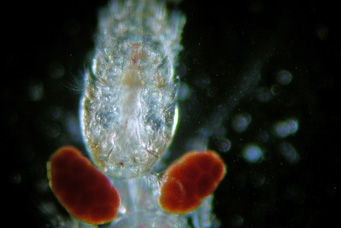Clausidium vancouverense
From ize
Clausidium vancouverense is a symbiotic parasite of the ghost shrimp Neotrypaea californiensis (=Callianassa californiensis)[1]. It is one of six species in the genus Clausidium and is found with their host in the Pacific Ocean from Alaska to Baja California[2].
| Taxonomy | |
|---|---|
| Kingdom: Animalia | |
| Phylum: Arthropoda | |
| Class: Maxillopoda | |
| Order: Poecilostomatoida | |
| Family: Noctuoidea | |
| Genus: Clausidium | |
| Species: C. vancouverense |
Contents |
Description
Females are larger than males with males sometimes attached to their dorsal thorax[3].
 |
Several features separate them from other species in their genre. Namely the blade-like seta on the first leg of females and the small lateral hairs on the setae of the fifth leg on females. In males, the structure of the maxilliped is unique. The egg sacs are seen in the above picture.
Common Name
Red Copepod
Size
Females range in size from 1.086-1.222 mm.
Ecology
Copepod distribution of a similar species Clausidium dissimile on ghost shrimp were positively correlated to the host's body size[4] but host sex did not affect distribution[5] C. vancouverense have suckers for staying on the branchial cavity of their host.
Footnotes
- ↑ Humes, A.D. 1949. A new copepod parasitic on mud shrimps in Louisiana. Transactions of the American Microscopical Society. 68:93-103.
- ↑ http://www.mbayaq.org/efc/living_species/default.asp?hOri=0&hab=3&inhab=456
- ↑ Wilson, C.B. 1935. Copepods from the Pacific coast. American Midland Naturalist. 16:776-797.
- ↑ Marin, S.L. & G.M. Nascimento, 1975. Host body size and habitat as factors affecting the distribution and abundance of the copepod Clausidium. Revista Chilena de Historia Natural. 66:427-437
- ↑ Corsetti J.L. & K.M. Strasser, 2003. Host selection in the symbiotic copepod Clausidium dissimile in two sympatric populations. Marine Ecology-Progressive Series. 256:151-159

